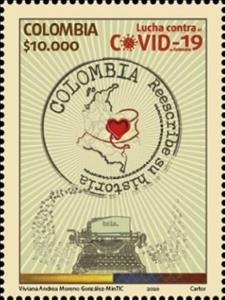Stamp: Fight Against COVID-19 : Colombia Rewrites Its History (Colombia 2020)
Fight Against COVID-19 : Colombia Rewrites Its History (Colombia 2020)
26 August (Colombia ) within release Fight Against COVID-19 : Colombia Rewrites Its History goes into circulation Stamp Fight Against COVID-19 : Colombia Rewrites Its History face value 10,000 Colombian peso
| Stamp Fight Against COVID-19 : Colombia Rewrites Its History in catalogues | |
|---|---|
| Colnect codes: | Col: CO 2020-12 |
Stamp is vertical format.
Printed by Cartor Security Printings, France. Designed by Viviana A. Moreno Gonzalez. This postal issue is aimed to raise funds and support the 'Computers for Education' program in the acquisition of computers and other technologies, which will allow the generation of conditions necessary for the access, appropriation and use of technologies in the educational offices of the country.Stamp Fight Against COVID-19 : Colombia Rewrites Its History it reflects the thematic directions:
A flag is a piece of fabric (most often rectangular or quadrilateral) with a distinctive design that is used as a symbol, as a signaling device, or as decoration. The term flag is also used to refer to the graphic design employed, and flags have since evolved into a general tool for rudimentary signalling and identification, especially in environments where communication is similarly challenging (such as the maritime environment where semaphore is used). National flags are patriotic symbols with varied wide-ranging interpretations, often including strong military associations due to their original and ongoing military uses. Flags are also used in messaging, advertising, or for other decorative purposes. The study of flags is known as vexillology, from the Latin word vexillum, meaning flag or banner.
A map is a symbolic depiction emphasizing relationships between elements of some space, such as objects, regions, or themes. Many maps are static, fixed to paper or some other durable medium, while others are dynamic or interactive. Although most commonly used to depict geography, maps may represent any space, real or imagined, without regard to context or scale, such as in brain mapping, DNA mapping, or computer network topology mapping. The space being mapped may be two dimensional, such as the surface of the earth, three dimensional, such as the interior of the earth, or even more abstract spaces of any dimension, such as arise in modeling phenomena having many independent variables. Although the earliest maps known are of the heavens, geographic maps of territory have a very long tradition and exist from ancient times. The word "map" comes from the medieval Latin Mappa mundi, wherein mappa meant napkin or cloth and mundi the world. Thus, "map" became the shortened term referring to a two-dimensional representation of the surface of the world.
A typewriter is a mechanical or electromechanical machine for typing characters. Typically, a typewriter has an array of keys, and each one causes a different single character to be produced on paper by striking an inked ribbon selectively against the paper with a type element. Thereby, the machine produces a legible written document composed of ink and paper. By the end of the 19th century, a person who used such a device was also referred to as a typewriter


